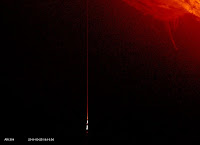
At 16:16:08 UT on March 25, 2011 and again at 16:17:08 (see on left) bright flashes were seen in the lower left corner of images in the AIA He II 304 bandpass. There has been some speculation about the cause of these flashes. They are proton hits on the CCD that records the images in this telescope. As the proton moves through the CCD it ionizes the silicon and leaves electrons in its wake. Proton hits are a main cause of hot pixels or spikes in any space-based CCD. They are often seen in images recorded by the LASCO coronagraphs on SOHO. SDO instruments have shielding to keep the low energy protons out of the CCD, but as solar activity picks up the number of hits by high energy protons will increase.
When you go to the original FITS data from 16:16:08, enlarge the image (left), and apply a rainbow color table that maps small values to blue and large values to red, you can see the some pixels with electrons caused by the proton before it slowed enough to have the large ionization signature. In these examples the number of electrons left behind is so large the CCD pixels can’t hold them and they bleed into adjacent pixels, causing the funny shapes. Because the pixels are completely full the electrons are not completely shifted from pixel to pixel during the bucket brigade we call readout. This remnant charge causes the long vertical tail as that extra charge is slowly removed. This part of the CCD is read out through the lower left corner, so spikes in this part of the CCD always have the readout tail straight up. Each instrument on SDO must remove the spikes from their data during data processing so that only solar information is sent to data archive. Because we get the images before the final reduction is done we get to see the spikes.
Could they be interstellar spacecraft? No. Only light with a wavelength very close to 304 Å is passed by the filters in front of the CCD of this telescope configuration. At this wavelength metals do not reflect light very well except at grazing angles. This principle is used to construct grazing incidence telescopes on Chandra and Yohkoh. But this means you would see an object in reflection only as it passed in front of the Sun. Neither feature in these images is in such a position.
We do not see interstellar “Iridium flashes” in the SDO telescopes; we do see protons hits on the CCDs.
